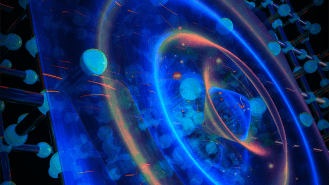Nearly 70 years after it was predicted to exist, an international team of researchers has stumbled upon the elusive “demon” particle — and it could help in the hunt for new superconductors.
The background: Atoms are the building blocks of matter, and electrons are one of the building blocks of atoms. Alone, these subatomic particles have a negative charge and a tiny bit of mass, but they can combine in solids to form “composite particles” with new charges and masses.
In 1956, theoretical physicist David Pines predicted the existence of a composite particle in solids that would have no mass, no electric charge, and wouldn’t interact with light. He then gave it a truly metal name: the demon particle.
Finding something with characteristics that make it nearly impossible to detect is, unsurprisingly, really hard.
The challenge: The demon particle has since been suspected of playing a role in phenomena exhibited by some metals, including superconductivity, which is the ability of a material to transport electricity without any resistance.
No one has been able to confirm the demon particle’s existence, though — finding something that may or may not exist and has characteristics that make it nearly impossible to detect is, unsurprisingly, really hard.
What’s new: A research team led by Peter Abbamonte, a physics professor at the University of Illinois Urbana-Champaign, has finally discovered the elusive demon particle — by accident.
“We weren’t even looking for it,” said Abbamonte. “But it turned out we were doing exactly the right thing, and we found it.”
“Demons are not in the mainstream. The possibility came up early on, and we basically laughed it off.”
Ali Husain
How it works: Abbamonte’s team discovered the demon particle in strontium ruthenate, a metal that’s similar to high-temperature superconductors but is not a superconductor itself.
(“High-temperature” is a relative term: these materials are superconductive above -321.1 F. Most known superconductors only work at really low temperatures, closer to absolute zero. Finding a genuine room-temperature superconductor would be a holy grail of science.)
The researchers were examining strontium ruthenate using a technique they’d developed called “momentum-resolved electron energy-loss spectroscopy” (M-EELS), which shoots electrons into a material to help reveal its features, when they spotted something unusual in the data.
“At first, we had no idea what it was,” said researcher Ali Husain. “Demons are not in the mainstream. The possibility came up early on, and we basically laughed it off. But, as we started ruling things out, we started to suspect that we had really found the demon.”
“Most big discoveries are not planned. You go look somewhere new and see what’s there.”
Peter Abbamonte
Follow-up research confirmed the discovery.
“Pines’ prediction of demons necessitates rather specific conditions, and it was not clear to anyone whether strontium ruthenate should have a demon at all,” said researcher Edwin Huang. “We had to perform a microscopic calculation to clarify what was going on.”
(If you want all the gory details on what the demon particle is and how it was discovered, see the presentation embedded below.)
Looking ahead: Now that Abbamonte’s team has proven the existence of the demon particle and demonstrated a technique for finding it, future studies could look for demons in other materials.
That could not only help determine whether the particle does play a role in superconductivity and other phenomena, but perhaps lead to the discovery of something entirely unexpected.
“[This study] speaks to the importance of just measuring stuff,” said Abbamonte. “Most big discoveries are not planned. You go look somewhere new and see what’s there.”
We’d love to hear from you! If you have a comment about this article or if you have a tip for a future Freethink story, please email us at [email protected].






